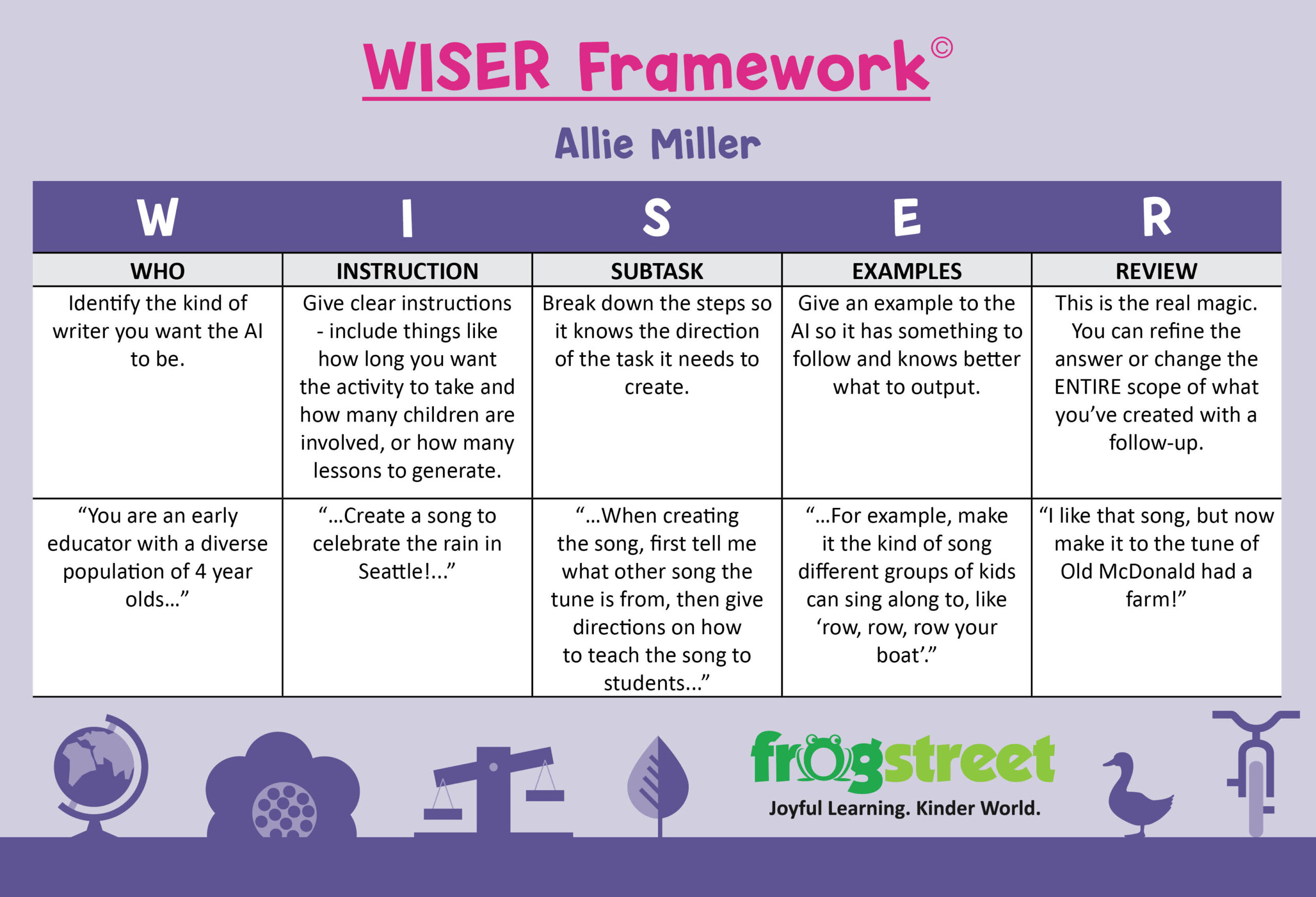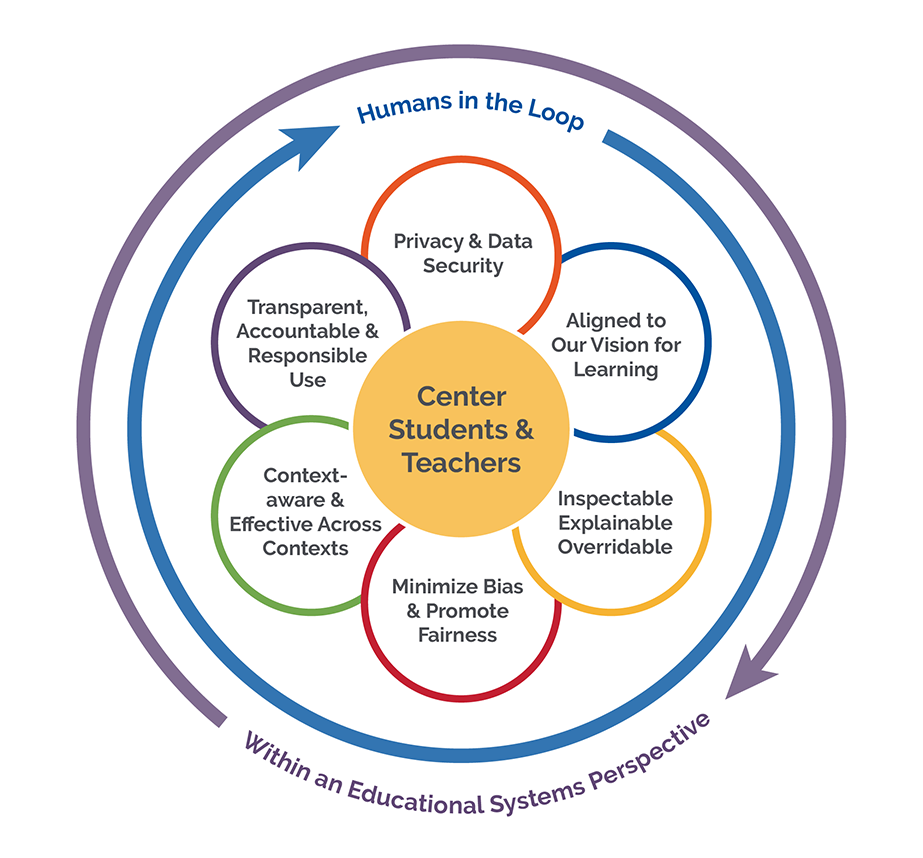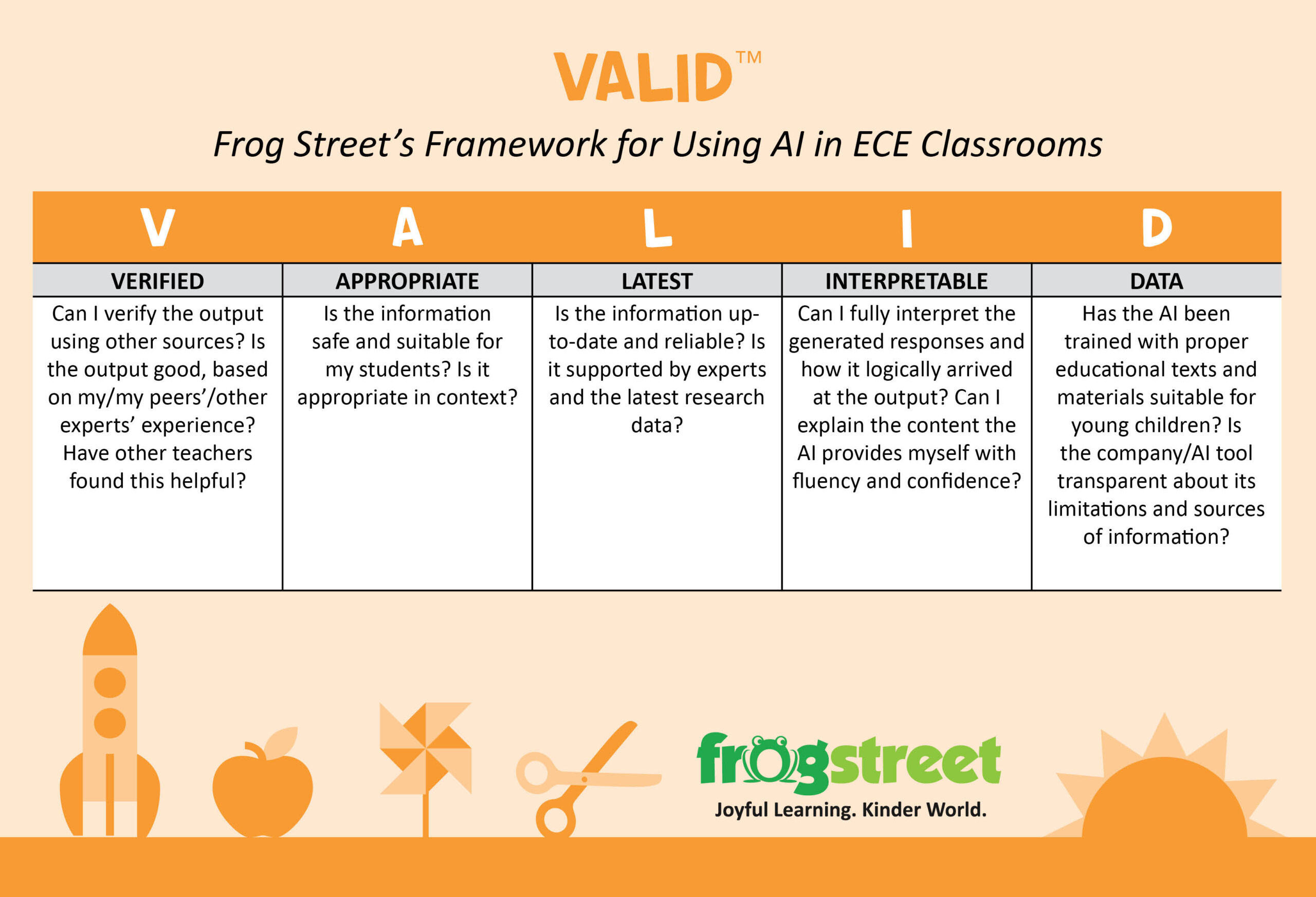April 4, 2024 / AI Blog
AI in Early Childhood Education: The Do’s and Don’ts
About This AI in Early Childhood Education Guide
This multi-blog series from Frog Street dives into the realm of Artificial Intelligence (AI) and its implications for Early Childhood Education (ECE). We aim to demystify AI, explain its function, offer guidance on seamless integration, and highlight both its potential and pitfalls within the classroom setting.
In this guide, we will explain the importance of AI in early childhood education as a tool rather than a standalone solution for educators. At the same time, AI presents exciting opportunities; it cannot replace the need for meticulously crafted curricula and expert-vetted content. If you want to learn more about artificial intelligence and its role in early childhood education, this guide is here to help.
This guide to AI in early childhood education was entirely written, reviewed, and vetted by a team of subject matter experts in the fields of technology, data science, AI, and early childhood education. ChatGPT was used to assist in idea generation, research, and generating examples.
Table of contents:
What is AI and how do Generative AIs like chatGPT work?
For some educators, Artificial Intelligence (AI) can sound intimidating or futuristic. However, it’s already being used in small but meaningful ways in classrooms worldwide. At its core, AI simply refers to computer systems designed to perform tasks we have historically thought of as requiring human intelligence and decision-making. The key is that it’s a tool – one that teachers can control and direct to fit educational goals, but one that needs to be used properly and responsibly.
Educators wield the power to harness AI’s capabilities to align with educational objectives, emphasizing the importance of thoughtful integration and conscientious oversight. As we navigate the evolving landscape of education, embracing AI as a collaborative partner in the teaching process opens doors to innovative approaches and enriched learning experiences for students.
Generative AI is a type of artificial intelligence that can create new data or content, such as text, images, or even music, by learning patterns and generating output based on what it has been trained on. It essentially “creates” things based on its understanding of existing examples. You may have heard of OpenAI’s ChatGPT and Google’s Gemini. In their cases, based on an extensive library of previously created text (referred to as its “training data”), they can make relationships between words to create new text in response to prompts – be it a grocery list based on a meal list, or a lesson plan based on a specific standard.
Using generative AI is like building a puzzle, one piece at a time, finding the next logical piece based on the patterns it has learned and can recognize. However, it doesn’t have real-time information or a deep understanding of the world beyond its training, so it can sometimes produce incorrect, out-of-context, or just made-up responses. Understanding the limitations and risks of AI is essential in determining the role that this innovative software can play within a classroom setting.
If you’ve never used an AI tool before and would like to try it, the most popular and most accessible for beginners is ChatGPT, which is free to use for the base level. ChatGPT is a conversational AI model developed by OpenAI that is designed to engage in text-based conversations with users. ChatGPT is trained on vast text data from the internet, allowing it to generate human-like responses to a wide range of queries and prompts. It can be used for various purposes, including answering questions, providing information, offering recommendations, and even engaging in creative dialogue.
Want to learn more about ChatGPT or try it out for yourself? Frog Street can help! Click here for a beginner’s guide to get you started!
How can AI help education providers?
The vast potential of AI in early childhood education is undeniable. By drawing insights from the experiences of our peers in higher education and K-12 learning, we recognize the unique context surrounding the integration of AI in early childhood education. While discussions in higher grades often revolve around mitigating the influence of AI on student-created work and writing abilities, early education presents a distinct opportunity. Here, it can serve as a valuable ally to educators, streamlining tasks and freeing up valuable time for them to prioritize what truly matters—nurturing relationships with their children. By leveraging AI tools effectively, educators can enhance efficiency, allowing for a more focused and enriching early education experience for teachers and children.
Teachers can leverage AI in early childhood education to help adapt or personalize their lessons, jump start professional development, gather research, get ideas for activities, help save time on day-to-day tasks, and much more!
Using AI: How to write good prompts
Writing prompts are instructions so your AI tool can create the kind of content you want, and writing good prompts is critical to generating higher-quality responses. Improper prompting can leave too much room for the AI to interpret and fill in gaps unintendedly, introduce biases, develop less helpful responses, etc. We like using the WISER framework © Allie Miller.
Once you get used to prompting, it will start feeling pretty natural! Then, you can adjust this to fit your needs and workflow according to what works better in the given context.
“Gotchas” of Pure Tech/AI Tools to Watch Out For
AI in early childhood education exhibits remarkable capabilities, from crafting engaging children’s stories to analyzing data and devising lesson plans. However, when deployed without tailored training for early education contexts, the outcomes may prove misleading, incomplete, or erroneous. Instances abound where AI-generated content reflects biases or inaccuracies due to inadequate training or incomplete datasets. Some of us may remember the Jurassic Park movies and how scientists filled in Dinosaur DNA gaps with frog DNA and how well that turned out! To quote Jeff Goldblum’s character: “Scientists were so preoccupied with whether or not they could, they didn’t stop to think if they should”…yes, that’s just a joke, but have you seen this recent story about Microsoft, or the concerns around Amazon Q?
Despite advancements, AI inherently lacks the contextual understanding and nuanced comprehension characteristic of human educators and experts, making errors inevitable. Thus, while AI in early childhood education offers invaluable assistance to educators, it must be supplemented by human oversight to navigate nuanced situations effectively and mitigate the risks of misinterpretation or misrepresentation.
There is an opinion in the EdTech industry that AI in early childhood education can help “equalize” education, as it can help offset the current high turnover and give more inexperienced teachers the tools and guidance they need to bridge the gap compared to more experienced and well-trained teachers. While AI can help bring efficiencies and empower teachers in their day-to-day in unique ways, AI alone can cause more harm in that area, widening the gap instead by not providing them with the proper information, understanding, and ability to impact sustained learning. Ultimately, AI in early childhood education alone cannot replace a quality and efficacious curriculum designed and vetted to teach and support student learning for long-term success pedagogically…and certainly, never replace a great teacher!
This AI software is new, but don’t worry; the industry is working on solutions and guidelines to ensure safe and fair usage, including ethical and safety considerations! Recently, the White House issued an Executive Order on AI to create protections over personal data for AI tools, and the US Dept. of Education’s Office of Educational Technology released a guide on integrating AI into classrooms in early 2023.
This is why having humans in the loop, training and verifying the output with subject matter experts, is essential, and using such technologies needs to be treated not as an opportunity but as a responsibility. This can be done in various ways – including standards and sub-standards in training data, using appropriate curriculum as example output, and having experts be integrated in verifying and approving content before it makes it to a teacher’s classroom and influences children.
Key considerations when engaging with AI
As responsible educators, some key considerations to make when utilizing AI in early childhood education include:
-
- Carefully evaluate AI tools for safety, privacy, and age-appropriateness before adopting them.
- Using AI thoughtfully as a complement to, not a replacement for, skilled human teachers. The teacher must remain the heart of the classroom.
- Looking for bias in data/algorithms and ensuring AI does not inherit harmful stereotypes.
- Giving transparency into how AI applications work so teachers and children can develop informed views.
Does that sound intimidating? We get it! We know that AI software can be daunting, but don’t get discouraged! We developed a simple acronym to help you think about and validate these things: VALID™ (get it?). Consider this a starter set of guiding questions to ask yourself when using AI tools and their output:
The bottom line…
The bottom line is AI gives educators some fantastic new capabilities, but it cannot replace vetted curricula or quality educators. Like any technology, it requires watchful eyes and wise use. Teachers should explore AI with cautious optimism, embracing the potential benefits while maintaining a sense of responsibility and carefulness. Together, educators can shape AI applications to truly serve teachers and children and view AI as an empowerment tool to enhance the capabilities of Subject Matter Experts, not a replacement. Conversations should continue about thoughtfully integrating this technology into the classroom while keeping human experts and educators firmly in the loop.
Apply what you learned!
Now that you have the tools and understand better how to use them, how about some practice? We created some simple examples where AI tools could be implemented and applied the WISER© and VALID™ frameworks introduced here to generate and evaluate the output. We highly recommend you check them out:
- Teacher’s Guide to AI: Apply your knowledge – Adaptive Teaching example
- Teacher’s Guide to AI: Apply your knowledge – Personalized Learning example
- Teacher’s Guide to AI: Apply your knowledge – Idea generation for Activities example
- Teacher’s Guide to AI: Apply your knowledge – Administrative Efficiencies example
- Teacher’s Guide to AI: Apply your knowledge – Accessibility example
- Teacher’s Guide to AI: Apply your knowledge – Springboard for Professional Development/Research example



